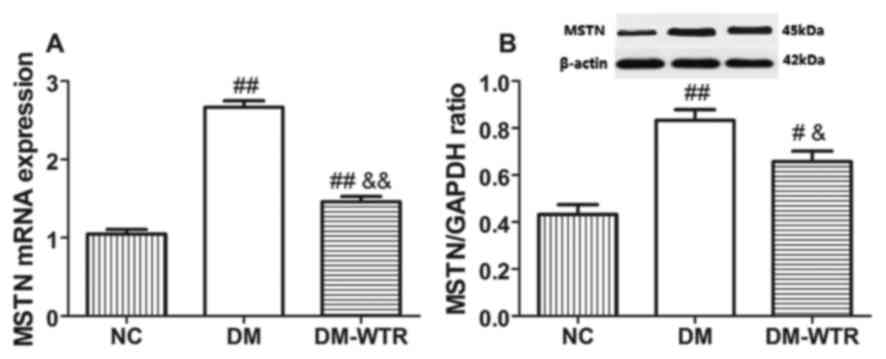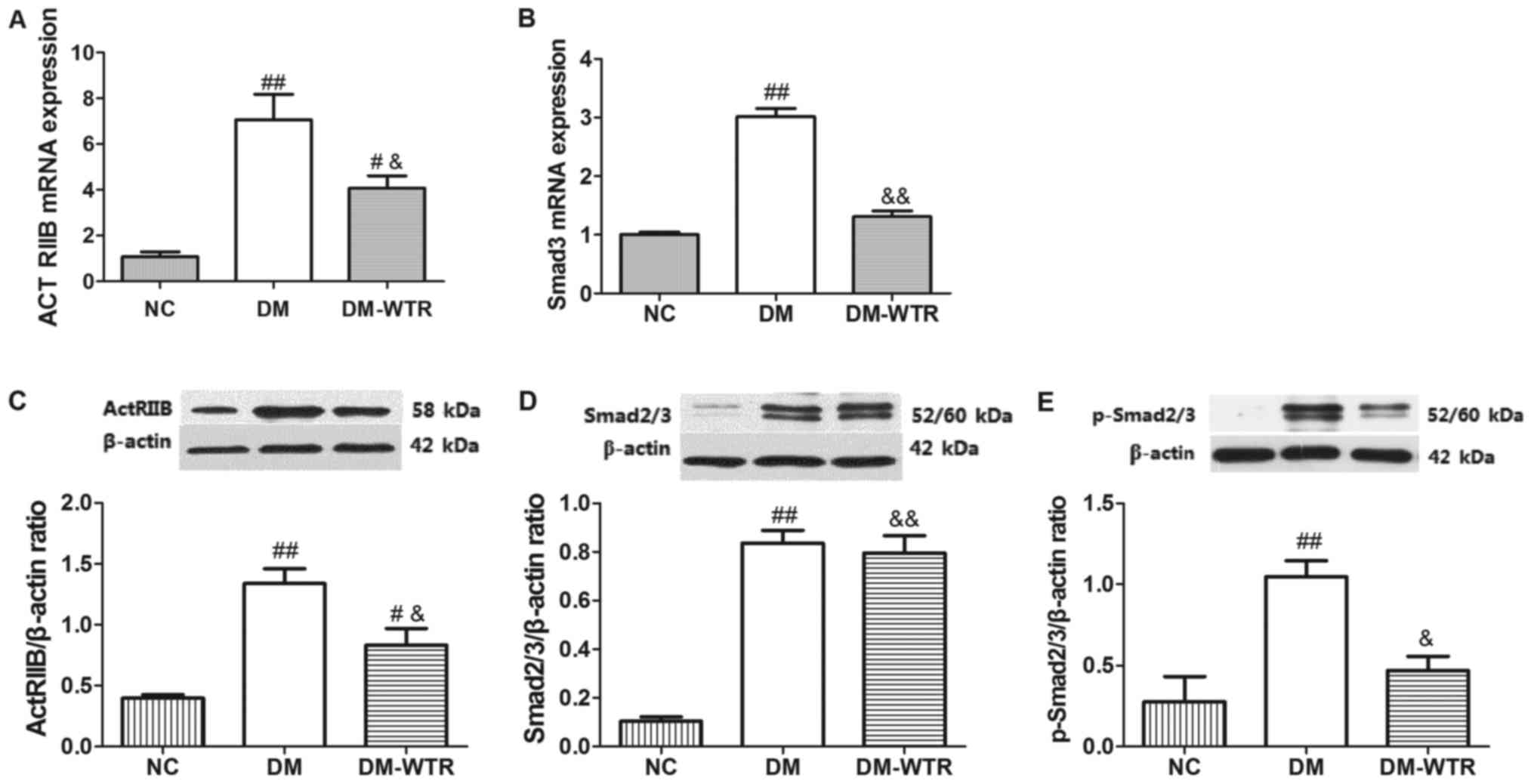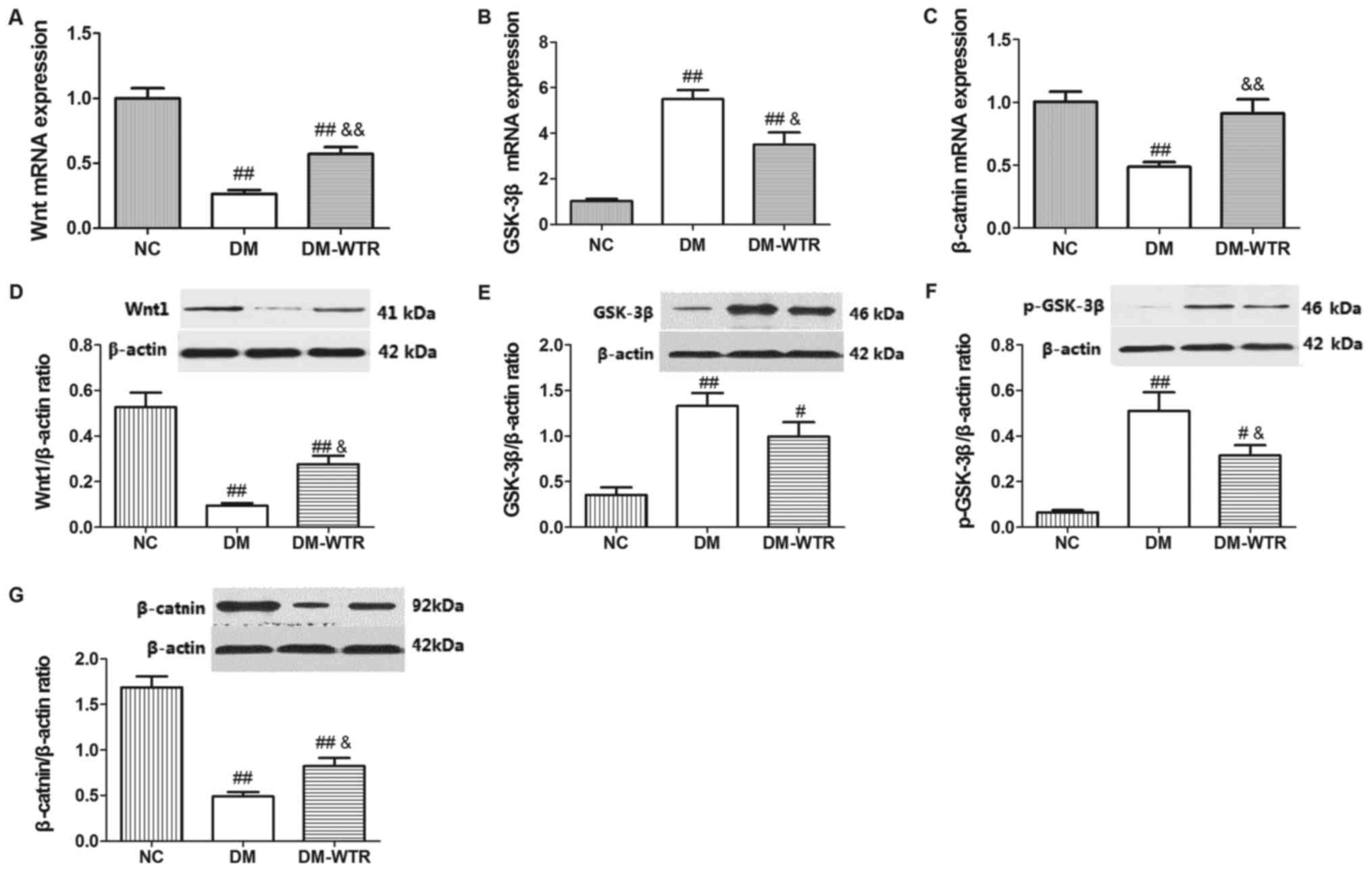|
1
|
Kemink SA, Hermus AR, Swinkels LM,
Lutterman JA and Smals AG: Osteopenia in insulin-dependent diabetes
mellitus; prevalence and aspects of pathophysiology. J Endocrinol
Invest. 23:295–303. 2000. View Article : Google Scholar : PubMed/NCBI
|
|
2
|
Campos Pastor MM, López-Ibarra PJ,
Escobar-Jiménez F, Serrano Pardo MD and García-Cervigón AG:
Intensive insulin therapy and bone mineral density in type 1
diabetes mellitus: A prospective study. Osteoporos Int. 11:455–459.
2000. View Article : Google Scholar : PubMed/NCBI
|
|
3
|
Erdal N, Gürgül S, Demirel C and Yildiz A:
The effect of insulin therapy on biomechanical deterioration of
bone in streptozotocin (STZ)-induced type 1 diabetes mellitus in
rats. Diabetes Res Clin Pract. 97:461–467. 2012. View Article : Google Scholar : PubMed/NCBI
|
|
4
|
López-Ibarra PJ, Pastor MM,
Escobar-Jiménez F, Pardo MD, González AG, Luna JD, Requena ME and
Diosdado MA: Bone mineral density at time of clinical diagnosis of
adult-onset type 1 diabetes mellitus. Endocr Pract. 7:346–351.
2001. View Article : Google Scholar : PubMed/NCBI
|
|
5
|
Roggen I, Gies I, Vanbesien J, Louis O and
De Schepper J: Trabecular bone mineral density and bone geometry of
the distal radius at completion of pubertal growth in childhood
type 1 diabetes. Horm Res Paediatr. 79:68–74. 2013. View Article : Google Scholar : PubMed/NCBI
|
|
6
|
Saha MT, Sievänen H, Salo MK, Tulokas S
and Saha HH: Bone mass and structure in adolescents with type 1
diabetes compared to healthy peers. Osteoporos Int. 20:1401–1406.
2009. View Article : Google Scholar : PubMed/NCBI
|
|
7
|
Albright F: Bone development in diabetic
children: A roentgen study. Am J Med Sci. 174:313–319. 1948.
|
|
8
|
Diabetes Control and Complications Trial
Research Group, ; Nathan DM, Genuth S, Lachin J, Cleary P, Crofford
O, Davis M, Rand L and Siebert C: The effect of intensive treatment
of diabetes on the development and progression of long-term
complications in insulin-dependent diabetes mellitus. N Engl J Med.
329:977–986. 1993. View Article : Google Scholar : PubMed/NCBI
|
|
9
|
Moy CS, Songer TJ, LaPorte RE, Dorman JS,
Kriska AM, Orchard TJ, Becker DJ and Drash AL: Insulin-dependent
diabetes mellitus, physical activity, and death. Am J Epidemiol.
137:74–81. 1993. View Article : Google Scholar : PubMed/NCBI
|
|
10
|
Kriska AM, LaPorte RE, Patrick SL, Kuller
LH and Orchard TJ: The association of physical activity and
diabetic complications in individuals with insulin-dependent
diabetes mellitus: The Epidemiology of Diabetes Complications
Study-VII. J Clin Epidemiol. 44:1207–1214. 1991. View Article : Google Scholar : PubMed/NCBI
|
|
11
|
Yee CS, Xie L, Hatsell S, Hum N, Murugesh
D, Economides AN, Loots GG and Collette NM: Sclerostin antibody
treatment improves fracture outcomes in a Type I diabetic mouse
model. Bone. 82:122–134. 2016. View Article : Google Scholar : PubMed/NCBI
|
|
12
|
Rodda SJ and McMahon AP: Distinct roles
for Hedgehog and canonical Wnt signaling in specification,
differentiation and maintenance of osteoblast progenitors.
Development. 133:3231–3244. 2006. View Article : Google Scholar : PubMed/NCBI
|
|
13
|
Espe K, Galler A, Raila J, Kiess W and
Schweigert FJ: High-normal C-reactive protein levels do not affect
the vitamin A transport complex in serum of children and
adolescents with type 1 diabetes. Pediatr Res. 62:741–745. 2007.
View Article : Google Scholar : PubMed/NCBI
|
|
14
|
Funaba M, Ogawa K and Abe M: Expression
and localization of activin receptors during endochondral bone
development. Eur J Endocrinol. 144:63–71. 2001. View Article : Google Scholar : PubMed/NCBI
|
|
15
|
Amthor H, Macharia R, Navarrete R,
Schuelke M, Brown SC, Otto A, Voit T, Muntoni F, Vrbóva G,
Partridge T, et al: Lack of myostatin results in excessive muscle
growth but impaired force generation. Proc Natl Acad Sci USA.
104:1835–1840. 2007. View Article : Google Scholar : PubMed/NCBI
|
|
16
|
Bialek P, Parkington J, Li X, Gavin D,
Wallace C, Zhang J, Root A, Yan G, Warner L, Seeherman HJ and
Yaworsky PJ: A myostatin and activin decoy receptor enhances bone
formation in mice. Bone. 60:162–171. 2014. View Article : Google Scholar : PubMed/NCBI
|
|
17
|
Tang L, Gao X, Yang X, Liu C, Wang X, Han
Y, Zhao X, Chi A and Sun L: Ladder-climbing training prevents bone
loss and microarchitecture deterioration in diet-induced obese
rats. Calcif Tissue Int. 98:85–93. 2016. View Article : Google Scholar : PubMed/NCBI
|
|
18
|
Tang L, Gao X, Yang X, Zhang D, Zhang X,
Du H, Han Y and Sun L: Combination of weight-bearing training and
anti-MSTN polyclonal antibody improve bone quality in rats. Int J
Sport Nutr Exerc Metab. 26:516–524. 2016. View Article : Google Scholar : PubMed/NCBI
|
|
19
|
Wan CX, Xu M, Huang SH, Wu QQ, Yuan Y,
Deng W and Tang QZ: Baicalein protects against endothelial cell
injury by inhibiting the TLR4/NF-κB signaling pathway. Mol Med Rep.
17:3085–3091. 2018.PubMed/NCBI
|
|
20
|
Balamurugan AN, Bottino R, Giannoukakis N
and Smetanka C: Prospective and challenges of islet transplantation
for the therapy of autoimmune diabetes. Pancreas. 32:231–243. 2006.
View Article : Google Scholar : PubMed/NCBI
|
|
21
|
Hirschhorn JN: Genetic epidemiology of
type 1 diabetes. Pediatr Diabetes. 4:87–100. 2003. View Article : Google Scholar : PubMed/NCBI
|
|
22
|
Aftab Guy D, Sandoval D, Richardson MA,
Tate D and Davis SN: Effects of glycemic control on target organ
responses to epinephrine in type 1 diabetes. Am J Physiol
Endocrinol Metab. 289:E258–E265. 2005. View Article : Google Scholar : PubMed/NCBI
|
|
23
|
Corigliano G, Iazzetta N, Corigliano M and
Strollo F: Blood glucose changes in diabetic children and
adolescents engaged in most common sports activities. Acta Biomed.
77 Suppl 1:S26–S33. 2006.
|
|
24
|
Levin ME, Boisseau VC and Avioli LV:
Effects of diabetes mellitus on bone mass in juvenile and
adult-onset diabetes. N Engl J Med. 294:241–245. 1976. View Article : Google Scholar : PubMed/NCBI
|
|
25
|
Santiago JV, McAlister WH, Ratzan SK,
Bussman Y, Haymond MW, Shackelford G and Weldon VV: Decreased
cortical thickness & osteopenia in children with diabetes
mellitus. J Clin Endocrinol Metab. 45:845–848. 1977. View Article : Google Scholar : PubMed/NCBI
|
|
26
|
Heath H III, Lambert PW, Service FJ and
Arnaud SB: Calcium homeostasis in diabetes mellitus. J Clin
Endocrinol Metab. 49:462–466. 1979. View Article : Google Scholar : PubMed/NCBI
|
|
27
|
McNair P, Madsbad S, Christiansen C, Faber
OK, Transbøl I and Binder C: Osteopenia in insulin treated diabetes
mellitus. Its relation to age at onset, sex and duration of
disease. Diabetologia. 15:87–90. 1978. View Article : Google Scholar : PubMed/NCBI
|
|
28
|
Almstedt HC, Grote S, Korte JR, Perez
Beaudion S, Shoepe TC, Strand S and Tarleton HP: Combined aerobic
and resistance training improves bone health of female cancer
survivors. Bone Rep. 5:274–279. 2016. View Article : Google Scholar : PubMed/NCBI
|
|
29
|
Gomes TS, Aoike DT, Baria F, Graciolli FG,
Moyses RMA and Cuppari L: Effect of aerobic exercise on markers of
bone metabolism of overweight and obese patients with chronic
kidney disease. J Ren Nutr. 27:364–371. 2017. View Article : Google Scholar : PubMed/NCBI
|
|
30
|
Junod A, Lambert AE, Stauffacher W and
Renold AE: Diabetogenic action of streptozotocin: Relationship of
dose to metabolic response. J Clin Invest. 48:2129–2139. 1969.
View Article : Google Scholar : PubMed/NCBI
|
|
31
|
Li RJ, Qiu SD, Tian H and Zhou SW:
Diabetes induced by multiple low doses of STZ can be spontaneously
recovered in adult mice. Dongwuxue Yanjiu. 34:238–243. 2013.(In
Chinese). PubMed/NCBI
|
|
32
|
Tsai CC, Chan P, Chen LJ, Chang CK, Liu Z
and Lin JW: Merit of ginseng in the treatment of heart failure in
type 1-like diabetic rats. Biomed Res Int. 2014:4841612014.
View Article : Google Scholar : PubMed/NCBI
|
|
33
|
Jorde R, Schirmer H, Njolstad I, Løchen
ML, Bøgeberg Mathiesen E, Kamycheva E, Figenschau Y and Grimnes G:
Serum calcium and the calcium-sensing receptor polymorphism
rs17251221 in relation to coronary heart disease, type 2 diabetes,
cancer and mortality: The Tromsø Study. Eur J Epidemiol.
28:569–578. 2013. View Article : Google Scholar : PubMed/NCBI
|
|
34
|
Henquin JC: Triggering and amplifying
pathways of regulation of insulin secretion by glucose. Diabetes.
49:1751–1760. 2000. View Article : Google Scholar : PubMed/NCBI
|
|
35
|
Pittas AG, Lau J, Hu FB and Dawson-Hughes
B: The role of vitamin D and calcium in type 2 diabetes. A
systematic review and meta-analysis. J Clin Endocrinol Metab.
92:2017–2029. 2007. View Article : Google Scholar : PubMed/NCBI
|
|
36
|
Mosso C, Hodgson MI, Ortiz T and Reyes ML:
Bone mineral density in young Chilean patients with type 1 diabetes
mellitus. J Pediatr Endocrinol Metab. 29:731–736. 2016. View Article : Google Scholar : PubMed/NCBI
|
|
37
|
Hamed EA, Faddan NH, Elhafeez HA and Sayed
D: Parathormone-25(OH)-vitamin D axis and bone status in children
and adolescents with type 1 diabetes mellitus. Pediatr Diabetes.
12:536–546. 2011.PubMed/NCBI
|
|
38
|
Halleen JM, Tiitinen SL, Ylipahkala H,
Fagerlund KM and Väänänen HK: Tartrate-resistant acid phosphatase
5b (TRACP 5b) as a marker of bone resorption. Clin Lab. 52:499–509.
2006.PubMed/NCBI
|
|
39
|
Rao Sirasanagandla S, Ranganath Pai
Karkala S, Potu BK and Bhat KM: Beneficial effect of cissus
quadrangularis Linn. on osteopenia associated with
streptozotocin-induced type 1 diabetes mellitus in male wistar
rats. Adv Pharmacol Sci. 2014:4830512014.PubMed/NCBI
|
|
40
|
Gopalakrishnan V, Arunakaran J, Aruldhas
MM and Srinivasan N: Effects of streptozotocin-induced diabetes
mellitus on some bone turnover markers in the vertebrae of
ovary-intact and ovariectomized adult rats. Biochem Cell Biol.
84:728–736. 2006. View Article : Google Scholar : PubMed/NCBI
|
|
41
|
Waud CE, Marks SC Jr, Lew R and Baran DT:
Bone mineral density in the femur and lumbar vertebrae decreases
after twelve weeks of diabetes in spontaneously diabetic-prone
BB/worcester rats. Calcif Tissue Int. 54:237–240. 1994. View Article : Google Scholar : PubMed/NCBI
|
|
42
|
Tang L, Yang X, Gao X, Du H, Han Y, Zhang
D, Wang Z and Sun L: Inhibiting myostatin signaling prevents
femoral trabecular bone loss and microarchitecture deterioration in
diet-induced obese rats. Exp Biol Med (Maywood). 241:308–316. 2016.
View Article : Google Scholar : PubMed/NCBI
|
|
43
|
Arounleut P, Bialek P, Liang LF, Upadhyay
S, Fulzele S, Johnson M, Elsalanty M, Isales CM and Hamrick MW: A
myostatin inhibitor (propeptide-Fc) increases muscle mass and
muscle fiber size in aged mice but does not increase bone density
or bone strength. Exp Gerontol. 48:898–904. 2013. View Article : Google Scholar : PubMed/NCBI
|
|
44
|
Inoue Y, Canaff L, Hendy GN, Hisa I,
Sugimoto T, Chihara K and Kaji H: Role of Smad3, acting
independently of transforming growth factor-beta, in the early
induction of Wnt-beta-catenin signaling by parathyroid hormone in
mouse osteoblastic cells. J Cell Biochem. 108:285–294. 2009.
View Article : Google Scholar : PubMed/NCBI
|
|
45
|
Lerner UH and Ohlsson C: The WNT system:
Background and its role in bone. J Intern Med. 277:630–649. 2015.
View Article : Google Scholar : PubMed/NCBI
|
|
46
|
Guo W, Flanagan J, Jasuja R, Kirkland J,
Jiang L and Bhasin S: The effects of myostatin on adipogenic
differentiation of human bone marrow-derived mesenchymal stem cells
are mediated through cross-communication between Smad3 and
Wnt/beta-catenin signaling pathways. J Biol Chem. 283:9136–9145.
2008. View Article : Google Scholar : PubMed/NCBI
|
|
47
|
Liu JD, Deng Q, Tian HH, Pang YT and Deng
GL: Wnt/glycogen synthase kinase 3β/β-catenin signaling activation
mediated sevoflurane preconditioning-induced cardioprotection. Chin
Med J (Engl). 128:2346–2353. 2015. View Article : Google Scholar : PubMed/NCBI
|
|
48
|
Steelman CA, Recknor JC, Nettleton D and
Reecy JM: Transcriptional profiling of myostatin-knockout mice
implicates Wnt signaling in postnatal skeletal muscle growth and
hypertrophy. FASEB J. 20:580–582. 2006. View Article : Google Scholar : PubMed/NCBI
|
|
49
|
Day TF, Guo X, Garrett-Beal L and Yang Y:
Wnt/beta-catenin signaling in mesenchymal progenitors controls
osteoblast and chondrocyte differentiation during vertebrate
skeletogenesis. Dev Cell. 8:739–750. 2005. View Article : Google Scholar : PubMed/NCBI
|


















